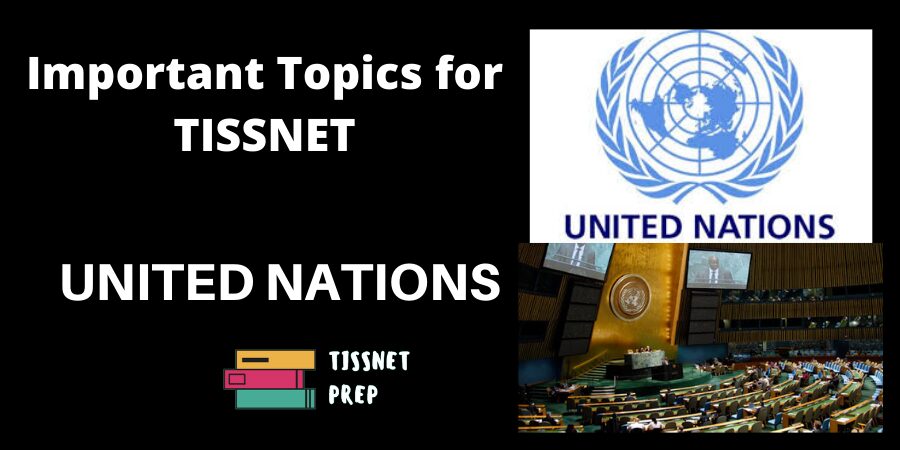Questions related to United Nations and its organisations are usually asked in TISSNET. Just Knowing the HQs and its head are not sufficient for TISSNET General Awareness Section. One needs to know its history and basic functions of the organisation.
Introduction
The United Nations (UN) is an international organization founded in 1945. It is currently made up of 193 Member States.
Its mission and work guided by the purposes and principles contained in its founding Charter and implemented by its various organs and specialised agencies.
Its activities include maintaining international peace and security, protecting human rights, delivering humanitarian aid, promoting sustainable development and upholding international law.
History of UN Foundation
- In 1899, the International Peace Conference was held in The Hague to elaborate instruments for settling crises peacefully, preventing wars and codifying rules of warfare.
- It adopted the Convention for the Pacific Settlement of International Disputes and established the Permanent Court of Arbitration, which began work in 1902. This court was the forerunner of UN International Court of Justice.
- The forerunner of the United Nations was the League of Nations, an organization conceived in circumstances of the First World War, and established in 1919 under the Treaty of Versailles “to promote international cooperation and to achieve peace and security.”
- The International Labour Organization (ILO) was also created in 1919 under the Treaty of Versailles as an affiliated agency of the League.
- The name “United Nations”, coined by United States President Franklin D. Roosevelt. A document called The Declaration by United Nations was signed in 1942 by 26 nations, pledging their Governments to continue fighting together against the Axis Powers (Rome-Berlin-Tokyo Axis) and bound them against making a separate peace.
- United Nations Conference on International Organization (1945)
- Conference held in San Francisco (USA), was attended by representatives of 50 countries and signed the United Nations Charter.
- The UN Charter of 1945 is the foundational treaty of the United Nations, as an inter-governmental organization.
Components
The main organs of the UN are
- the General Assembly,
- the Security Council,
- the Economic and Social Council,
- the Trusteeship Council,
- the International Court of Justice,
- and the UN Secretariat.
All the 6 were established in 1945 when the UN was founded.
1. General Assembly
- The General Assembly is the main deliberative, policymaking and representative organ of the UN.
- All 193 Member States of the UN are represented in the General Assembly, making it the only UN body with universal representation.
- Each year, in September, the full UN membership meets in the General Assembly Hall in New York for the annual General Assembly session, and general debate, which many heads of state attend and address.
- Decisions on important questions, such as those on peace and security, admission of new members and budgetary matters, require a two-thirds majority of the General Assembly.
- Decisions on other questions are by simple majority.
- The President of the General Assembly is elected each year by assembly to serve a one-year term of office.
- 6 Main Committees: Draft resolutions can be prepared for the General Assembly by its six main committees: (1) First Committee (Disarmament and International Security), (2) Second Committee (Economic and Financial), (3) Third Committee (Social, Humanitarian, and Cultural), (4) Fourth Committee (Special Political and Decolonization), (5) Fifth Committee (Administrative and Budgetary), (6)Sixth Committee (Legal).
- Each Member State may be represented by one person on each Main Committee and on any other committee that may be established upon which all Member States have the right to be represented.
- Member States may also assign advisers, technical advisers, experts or persons of similar status to these committees.
- Other Committees:
- General Committee: It meets periodically throughout each session to review the progress of the General Assembly and its committees and to make recommendations for furthering such progress. It is composed of the President of the General Assembly and 21 Vice-Presidents of the Assembly and the Chairmen of the six Main Committees. The five permanent members of the Security Council serve as Vice-Presidents, as well.
- Credentials Committee: It is mandated to examine the credentials of representatives of Member States and to report to the General Assembly.
2. Security Council
- It has primary responsibility, under the UN Charter, for the maintenance of international peace and security.
- The Security Council is made up of fifteen member states, consisting of five permanent members—China, France, Russia, the United Kingdom, and the United States—and ten non-permanent members elected for two-year terms by the General Assembly on a regional basis.
- “Veto power” refers to the power of the permanent member to veto (Reject) any resolution of Security Council.
- The unconditional veto possessed by the five governments has been seen as the most undemocratic character of the UN.
- Critics also claim that veto power is the main cause for international inaction on war crimes and crimes against humanity. However, the United States refused to join the United Nations in 1945 unless it was given a veto. The absence of the United States from the League of Nations contributed to its ineffectiveness. Supporters of the veto power regard it as a promoter of international stability, a check against military interventions, and a critical safeguard against U.S. domination.
3. Economic and Social Council (ECOSOC)
- It is the principal body for coordination, policy review, policy dialogue and recommendations on economic, social and environmental issues, as well as implementation of internationally agreed development goals.
- It has 54 Members, elected by the General Assembly for overlapping three-year terms.
- It is the United Nations’ central platform for reflection, debate, and innovative thinking on sustainable development.
- Each year, ECOSOC structures its work around an annual theme of global importance to sustainable development. This ensures focused attention, among ECOSOC’s array of partners, and throughout the UN development system.
- It coordinates the work of the 14 UN specialized agencies, ten functional commissions and five regional commissions, receives reports from nine UN funds and programmes and issues policy recommendations to the UN system and to Member States.
UN bodies within the purview of the ECOSOC:
- Specialized agencies
- International labour Organization (ILO)
- Food and Agriculture Organization of the United Nations (FAO)
- United Nations Educational, Scientific and Cultural Organization (UNESCO)
- World Health Organization (WHO)
- World Bank Group
- International Monetary Fund (IMF)
- International Civil Aviation Organization (ICAO)
- International Maritime Organization (IMO)
- International Telecommunication Union (ITU)
- Universal Postal Union (UPU)
- World Meteorological Organization (WMO)
- World Intellectual Property Organization (WIPO)
- International Fund for Agricultural Development (IFAD)
- United Nations Industrial Development Organization (UNIDO)
- World Tourism Organization (WTO)
- Functional commissions
- Statistical Commission
- Commission on Population and Development
- Commission for Social Development
- Commission on Human Rights
- Commission on the Status of Women
- Commission on Narcotic Drugs
- Commission on Crime Prevention and Criminal Justice
- Commission on Science and Technology for Development
- Commission on Sustainable Development
- United Nations Forum on Forests
- Regional Commissions
- Economic Commission for Africa (ECA)
- Economic and Social Commission for Asia and the Pacific (ESCAP)
- Economic Commission for Europe (ECE)
- Economic Commission for Latin America and the Caribbean (ECLAC)
- Economic and Social Commission for Western Asia (ESCWA)
- Standing Committees
- Committee for Programme and Coordination
- Commission on Human Settlements
- Committee on Non-Governmental Organizations
- Committee on Negotiations with Intergovernmental Agencies
- Committee on Energy and Natural Resources
4. Trusteeship Council
- It was established in 1945 by the UN Charter, under Chapter XIII.
- Trust territory is a non-self-governing territory placed under an administrative authority by the Trusteeship Council of the United Nations.
- A League of Nations mandate was a legal status for certain territories transferred from the control of one country to another following World War I, or the legal instruments that contained the internationally agreed-upon terms for administering the territory on behalf of the League of Nations.
- United Nations trust territories were the successors of the remaining League of Nations mandates, and came into being when the League of Nations ceased to exist in 1946.
- It had to provide international supervision for 11 Trust Territories that had been placed under the administration of seven Member States, and ensure that adequate steps were taken to prepare the Territories for self-government and independence.
- By 1994, all Trust Territories had attained self-government or independence. The Trusteeship Council suspended operation on 1 November 1994.
5. International Court of Justice (ICJ)
- The International Court of Justice is the principal judicial organ of the United Nations. It was established in June 1945 by the Charter of the United Nations and began work in April 1946.
- The ICJ is the successor of the Permanent Court of International Justice (PCIJ), which was established by the League of Nations in 1920.
6. Secretariat
- The Secretariat comprises the Secretary-General and tens of thousands of international UN staff members who carry out the day-to-day work of the UN as mandated by the General Assembly and the Organization’s other principal organs.
- The Secretary-General is chief administrative officer of the Organization, appointed by the General Assembly on the recommendation of the Security Council for a five-year, renewable term.
- UN staff members are recruited internationally and locally, and work in duty stations and on peacekeeping missions all around the world.

